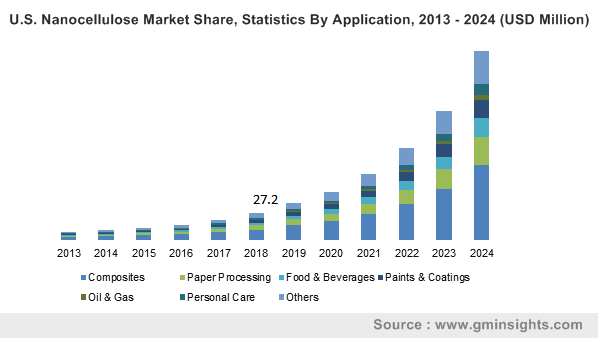Nanocellulose market to register a prodigious CAGR of 33.9% over 2017-2024, rising demand for lightweight & organic materials to expedite the industry growth
Publisher : Fractovia | Published Date : 2018-03-15Request Sample
The growing interest of the scientific community in a material that is strong, cost-effective, & eco-friendly is certain to fuel nanocellulose market trends in the forthcoming years. Despite being a relatively new material, nanocellulose has found applications in a variety of sectors including polymer composites, films, cosmetics, advanced biofuels, water treatment, electronics, and screens and coatings. Global concerns for the reduction of carbon footprint and bringing about more energy efficient materials have been instrumental in stimulating nanocellulose industry. Incidentally, research and development programs are being conducted on a regular basis to test the usability of nanocellulose in numerous other arenas, adding further to the application base of nanocellulose market.
U.S. Nanocellulose Market Size, By Application, 2013 – 2024 (USD Million)

The biodegradable nature of nanocellulose aids its application in numerous sectors that have deployed an ecofriendly manner of operationa. Nanocellulose offers promising and novel properties when applied as a biodegradable filler in composite manufacturing, self-standing thin films and coatings. Indeed, composites accounted for the largest share in nanocellulose market in 2016, with a valuation of USD 30 million. Aided by their widespread demand, nanocellulose industry size from composite applications will register a CAGR slightly lesser than 40% over 2017-2024. Nanocellulose reinforcement is regarded as the next generation of renewable reinforcement for high performance bio composites production as the product is found to be favorable for the mechanical and barrier properties of composites for synthetic polymer and biopolymer.
The paper and paperboard industry has largely adopted nanocellulose for the strengthening of paper. Nanocellulose has been found to improve the strength of wet and dry paper and paperboard by 20% to 70%, owing to which it is largely implemented by the paper processing industry. In 2016, paper processing accounted for 15% of the overall market share and is projected to attain remarkable proceeds over 2017-2024.
The food industry is another end-use sector that has quickly identified the benefits of nanocellulose gels. These gels can be used as a low-calorie substitute for carbohydrate additives. Additionally, nanocellulose is used as flavor carrier, thickener and suspension stabilizer in a wide variety of food products. Nanocellulose market garnered a valuation of USD 7.5 million from the food industry in 2016 and is expected to generate more revenue in the ensuing years, with the expansive use of non-caloric food thickeners.
Nanocellulose has also found a widespread demand in the food packaging industry due to its low environmental impact. The uncertainty of crude oil prices and rising consumer awareness about finding “green” solutions for the food packaging process has benefitted nanocellulose market immensely, as the product has emerged as a viable and preferable alternative to oil derived polymers that have been used in food packaging for long.
One of the most promising end-use domains for nanocellulose market is the automotive industry. Owing to unprecedented climate change, stringent regulations are being placed on automakers to develop and design novel functional materials that will improve the fuel efficiency of vehicles. This has led almost all North American and European OEMs to undertake drastic measures for weight reduction. This action has propelled the rapid emergence of nanocellulose as an extremely favorable material of choice and a high-performance nanomaterial that can potentially replace metals. The cost effectiveness and the fact that nanocellulose is grown rather than manufactured, makes it an economical substitute for light weight carbon composites that had been used in luxury cars like the all-electric BMW i3. The U.S. department of Energy has established that vehicle weight must be reduced by 50% by 2050. In the light of this regulatory scenario, nanocellulose market will register exponential growth via the automotive sector. Numerous manufacturers are already adopting this organic, light weight material that has the strength compared to Kevlar and costs a fraction of carbon fiber composites.
The ever-expanding defense and biomedical sectors have also been robustly adopting nanocellulose, serving to expand the application scope of nanocellulose industry. Research and development programs have been rampant across this business space, as scientists strive to expand the product’s end-use spectrum. Recently, scientists developed a material that is popularly being termed as ‘nanowood’ and it has been proved to be extremely effective as an insulating material. Nanowood’ has portrayed the potential of being used in building future energy efficient homes with reduced carbon footprint. It is thus, not surprising that nanocellulose market is all set to cross the billion-dollar milestone by 2024.